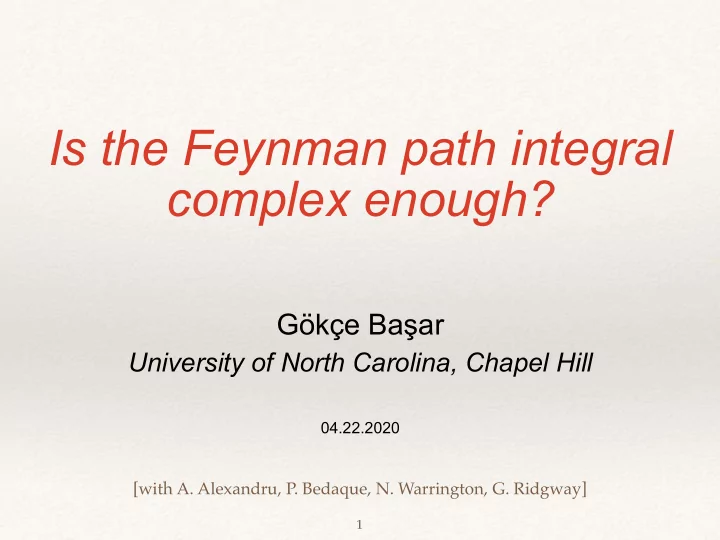

Is the Feynman path integral complex enough? Gökçe Ba ş ar University of North Carolina, Chapel Hill 04.22.2020 [with A. Alexandru, P. Bedaque, N. Warrington, G. Ridgway] � 1
Motivations first-principles studies of strongly interacting systems � 2
Motivations � 3
Motivations first-principles studies of strongly interacting systems early universe temperature quark gluon plasma heavy ion coll. 10 12 K critical point ?? hadron gas you are here neutron stars ∼ 310 MeV chemical potential � 4
Motivations: out-of-equilibrium, transport Heavy ion collisions: Quark gluon plasma is a liquid ! � 5
Motivations: out-of-equilibrium, transport Heavy ion collisions: Quark gluon plasma is a liquid ! � 6
Motivations: out-of-equilibrium, transport Heavy ion collisions: Quark gluon plasma is a liquid ! � 7
Motivations: out-of-equilibrium, transport Heavy ion collisions: Quark gluon plasma is a liquid ! � 8
Motivations: out-of-equilibrium, transport Quark gluon plasma is a liquid what is the viscosity, conductivity …? � 9
Motivations first-principles studies of strongly interacting systems T * T coh ? � ~ T T (K) � ( T ) � ~ T + T 2 S-shaped or � ~ T n upturns T FL ? (1 < n < 2) in � ( T ) A F � ~ T 2 d -wave SC M 0 0.05 0.1 0.15 0.2 0.25 0.3 Hole doping x [N.E. Hussey, ’08 ] � 10
Quantum Chromo Dynamics (QCD) We know how quarks and gluons interact Why not just compute the phase diagram, viscosity, equation of state, etc…? � 11
Quantum fluctuations animation: Derek Leinweber, University of Adelaide we are interested in expectation values examples: ⟨ n ⟩ ⇔ equation of state ⟨ T ab ( t ) T cd (0) ⟩ ⇔ viscosity ⟨ J ( t ) J (0) ⟩ ⇔ conductivity � 12
Feynman path integral ~ ""g7 VO1. UME 20, NUMBER 2 Aran. , 1948 Space- . . ime A~~~iroac. i 1:o . 5 on-. le. . a1:ivistic 4 uantuns . V. :ec. zanies R. P. I EvNMAN x(t) is the square of a sum space Ithaca, Veto York Cornell University, of contributions, one from each path in the region. The contribution from a single path is to be an exponential postulated Non-relativistic whose (imaginary) phase is the classical action (in units of h) way. It is, however, quantum mechanics is formulated here in a different mathematically to the familiar formulation. equivalent In quantum mechanics the probability for the path in question. The total contribution from all paths reaching x, t from the past is the of an event which can happen in several different is the absolute of a sum of ways square complex contributions, one from each alternative wave function P(x, t). This is shown to satisfy Schroedinger's way. The probability that a particle will be The relation to matrix equation. found to have a path x(t) lying somewhere within a region of space time is the square of a sum of contributions, one from each path in the region. The contribution from a single path is postulated to be an exponential whose (imaginary) phase is the classical action (in units of h) for the path in question. The total contribution from all paths reaching x, t from the past is the wave function P(x, t). This is shown to satisfy Schroedinger's equation. The relation to matrix and operator algebra is discussed. are indicated, Applications in particular to eliminate the coordinates of the field oscillators from the equations of quantum electrodynamics. I. INTRODUCTION classical action' to quantum mechanics. A proba- ; 'I is a curious is associated bility amplitude with an entire fact that historical modern motion of a particle as a function of time, rather & - quantum mechanics with two began quite than with a position of the particle at a simply di8'erent mathematical formulations: the differ- t S x ( ) ] ⅈ [ particular time. ⅇ ential equation of Schroedinger, and the matrix The formulation is mathematically equivalent algebra of Heisenberg. The two, apparently dis- to the There more usual formulations. are, to be mathe- similar approaches, were proved therefore, no fundamentally new results. How- matically equivalent. These two points of view x (t) ever, there is a pleasure in recognizing old things to complement were, destined one another and from a new point of view. Also, there are prob- to be ultimately in Dirac's synthesized trans- of view offers a lems for which the new point formation theory. distinct advantage. For example, if two systems This paper will describe what a is essentially A and 8 interact, the coordinates of one of the third formulation of non-relativistic quantum say 8, may be eliminated the systems, from theory. This formulation was suggested by some the motion of A. The inter- equations describing of Dirac's' ' remarks concerning the relation of � 13 3 Throughout this paper the term "action" will be used ' P. A. M. Dirac, The Principles of Quantum 3Eeohanics for the time of the along a path. integral Lagrangian (The Clarendon %'hen this path Press, Oxford, 1935), second edition, by a particle, is the one actually taken Section 33; also, Physik. Zeits. Sowjetunion 3, 64 (1933). moving classically, the integral more properly be should ' P. A. M. Dirac, Rev. Mod. Phys. 1'7, 195 (1945). called Hamilton's 6rst principle function. 367
Recommend
More recommend